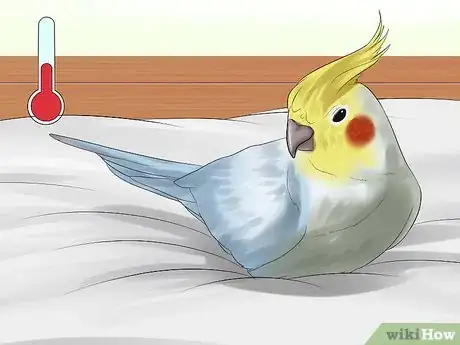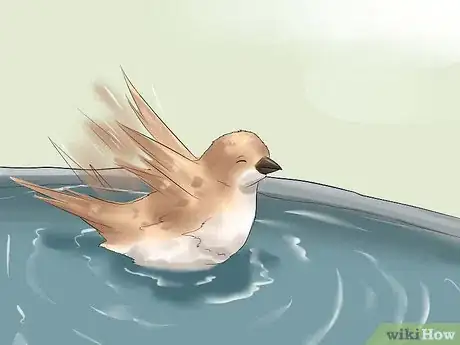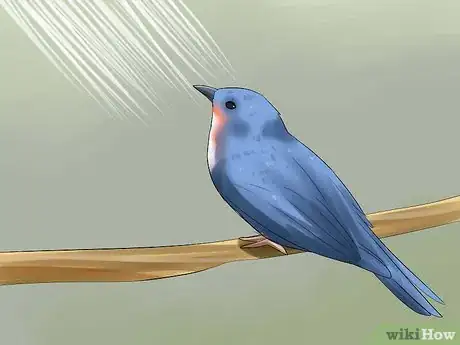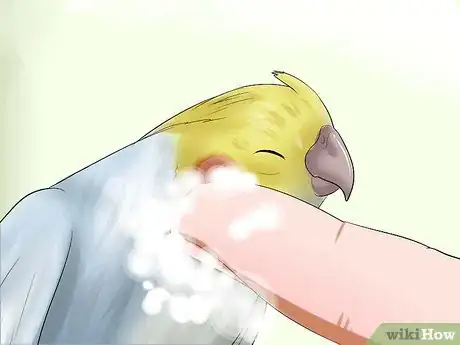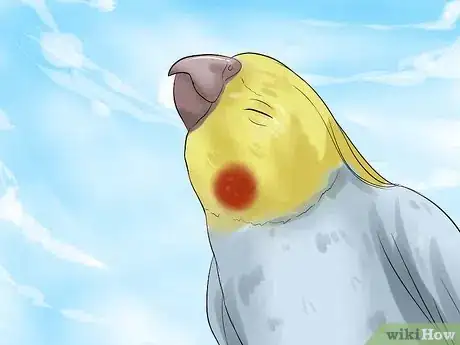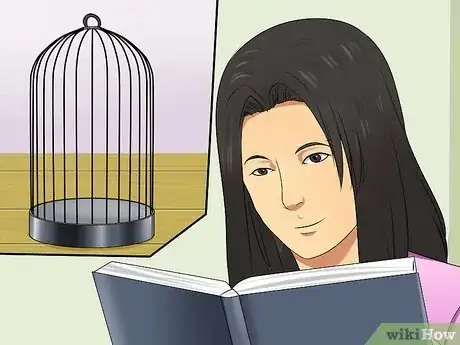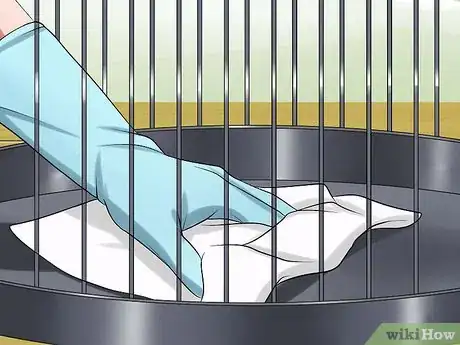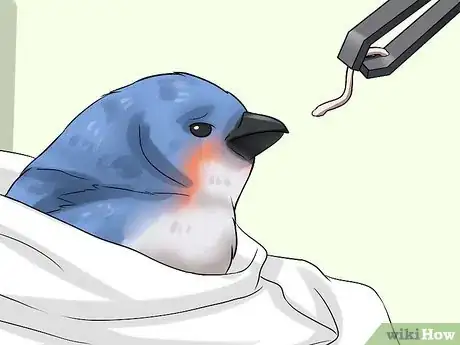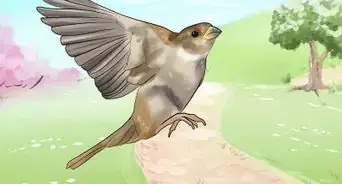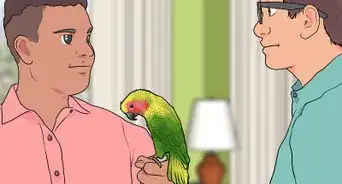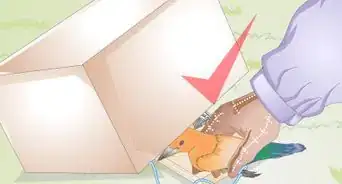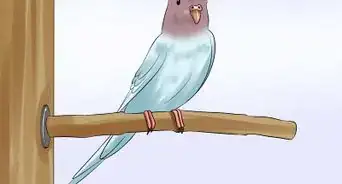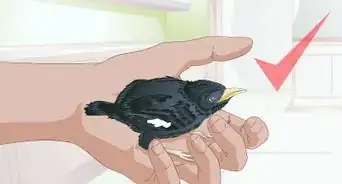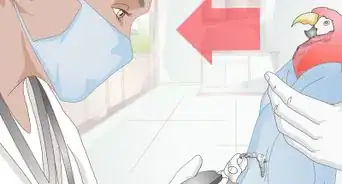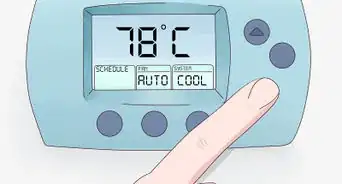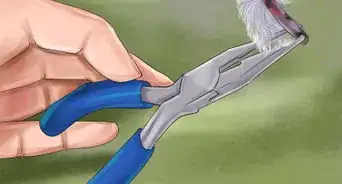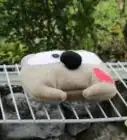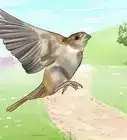This article was co-authored by Hayley Heartfield. Hayley Heartfield is a Bird Specialist and the Owner of About Birds, a Pet Bird Shop in Montgomery County, Texas. Hayley specializes in pet bird care, behavior, training, and breeding. Hayley studied Animal Science at Texas A&M. About Birds carries many species of birds and offers grooming and boarding services as well as bird care products.
There are 14 references cited in this article, which can be found at the bottom of the page.
wikiHow marks an article as reader-approved once it receives enough positive feedback. In this case, several readers have written to tell us that this article was helpful to them, earning it our reader-approved status.
This article has been viewed 141,564 times.
Birds are beautiful animals that often have colorful plumage or feathers. Most birds can take care of their own grooming needs, but you may find that sometimes you need to bathe your bird.[1] By gently misting and washing your pet bird, you can clean it. You should also maintain her cage, which can also help keep her clean.
Steps
Bathing Your Bird
-
1
-
2Let your bird bathe itself.[4] Many birds will bathe themselves without human help. Place a bath in your bird’s cage or in a place where it roams freely. Allow it to bathe itself or gently put it in the water to encourage it to clean itself.[5]
- Consider different types of baths such as shower perches, spray bottles, your kitchen sink, or a cage mounted bath bowl. Some birds will even rub themselves against wet branches as a cleaning method.[6]
- Fill the container with 1–2 inches (2.5–5.1 cm) of water so your bird can walk and preen as it likes.[7]
- Use lukewarm to room temperature water for your bird’s bath to keep it from chilling.[8]
- Avoid forcing your bird to bathe.[9]
- Use soap only in cases where your bird is oily and supervised by you.[10]
Advertisement -
3Mist your bird with lukewarm water.[11] Depending on how dirty your bird is, you may be able to clean it simply by misting it with water. Water is generally considered the most appropriate feather spray.[12] Gently spray your bird with a light mist of water until it appears clean.
- Make sure the spray is a mist or has very light pressure so that you don’t hurt your bird. For example, some birds may enjoy the spray from a sink.[13]
- Spray it every day or whenever it’s necessary.[14]
- Avoid misting or spraying water directly in your bird’s face.[15]
- Buy a commercial bird cleansing spray if you like, though this is generally unnecessary.[16]
-
4In most cases, you should not wash your bird with soap.[17] However, it may get into oil or some other substance that comes off only with soap. Use a mild soap and gently bathe your bird to clean it.[18]
- Make sure your bird is stable enough to wash with soap.[19]
- Fill a container with an inch or two of water. Add a low concentration dishwashing liquid like Dawn, which has been shown to effectively and easily remove oils without irritating birds’ eyes or skin.[20]
- Rinse your bird thoroughly with a gently mist or spray of water.[21] This is important so that it dries properly and its natural waterproofing process isn’t affected.[22]
- Talk to your vet if your bird is soiled with something that is difficult to remove, such as gum.[23]
-
5Allow your bird to air dry. Birds cannot fly with wet wings and air drying is an important part of waterproofing its feathers and getting it to fly again.[24] Leave your bird in a warm and sunny room to air dry completely.[25]
- Avoid using a hair dryer to dry your bird, which can burn its skin.[26]
- Avoid drying it with a towel. Allowing its feathers to dry and rearrange themselves naturally as part of the waterproofing process.[27]
- Stroke your bird gently in the direction of her feathers if the bird allows. This can help it dry.[28]
- Be aware that your bird’s chest may shiver after its bath. This doesn’t mean it's cold, but is a natural reaction to generate body heat that helps dry feathers.[29]
-
6Take your bird to a vet or professional cleaner. If your bird is especially dirty or you are unsure about cleaning it, schedule an appointment with her vet or a professional bird groomer. Either can safely and effectively clean your bird so it stays healthy and happy.
- Find a vet specifically for your bird at the Association of Avian Veterinarians.[30]
Maintaining Its Cage
-
1Learn the importance of cage maintenance. Birds can be very messy, but keeping their cages clean is an important part of keeping your bird clean, healthy, and happy.[31] Remove waste and other material such as feathers every day and do a deep cleaning every week or more often if necessary.[32] Make sure your bird’s cage is big enough and comfortable for her by considering the following elements:
- It should allow her to easily fly and spread her wings
- It should provide enough space for her food and water dishes
- It should have plenty of stimulation from toys and perches.[33]
-
2Tidy up the cage every day. You can promote your bird’s health and happiness by tidying up her cage every day.[34] Not only can this help keep you happy and your air fresh, but may also make deeper cleaning easier.
- Tidy up when your bird is playing outside of her cage. Remember to give your bird as much out-of-cage time as possible, which can make maintenance easier.[35]
- Change out her food and refill her bottle with fresh water.[36]
- Remove any seeds or nuts from the bottom of the cage. You’ll also need to remove any feces or other feathers from the bottom of the cage, too.[37]
- Place fresh liners of paper or towels on the bottom of the cage if you use it. Throw away the soiled paper.[38]
- Wipe down any surfaces with a vinegar and water mixture or an enzyme spray you purchase at a pet store.[39]
-
3Disinfect surfaces weekly. Because birds often produce big messes—from feces, food, and feathers—it’s important to deep clean the cage and its surfaces at least once a week.[40]
- Clean the cage when your bird is enjoying out-of-cage time.
- Remove everything from the cage, including toys and food and water dishes.
- Make a paste from baking soda and water or mix ¼ cup borax with 1 cup baking soda. These mixtures can scrub surfaces including perches and cage bars.
- Wipe down the cage bottom with a mixture of ½ cup borax, ¼ cup white vinegar, and 2 gallons of hot water.
- Wash food and water dishes with dish soap in the hottest water you can.
- Trim any frayed ends or splinters from perches and toys.
- Clean any areas around the cage such as blinds or carpets. You can wipe these down or vacuum them.
- Replace any liners at the bottom of the cage with fresh material.[41]
-
4Watch for signs of illness. Cage maintenance can alert you to possible illness in your bird.[42] If you notice any signs of illness in your bird, take her to the vet as soon as possible. Some of the signs of illness in bird visible through cage cleaning include:
- Not eating food
- Throwing up, including undigested or half-digested food stuck to strange places on the cage
- Discolored, undigested, or runny poop
- Ragged or plucked feathers at the bottom of the cage
- Blood anywhere in the cage.[43]
- Lack of urine or oddly colored urine.
Expert Q&A
-
QuestionWhat can I use to clean my bird cage?
 Melissa Nelson, DVM, PhDDr. Nelson is a Veterinarian who specializes in Companion and Large Animal Medicine in Minnesota, where she has over 18 years of experience as a veterinarian in a rural clinic. She received her Doctor of Veterinary Medicine from the University of Minnesota in 1998.
Melissa Nelson, DVM, PhDDr. Nelson is a Veterinarian who specializes in Companion and Large Animal Medicine in Minnesota, where she has over 18 years of experience as a veterinarian in a rural clinic. She received her Doctor of Veterinary Medicine from the University of Minnesota in 1998.
Veterinarian You can use plain dish soap and water, a diluted vinegar or bleach (followed by a thorough rinse with plain water) or a specifically designed cleaning product you can pick up at a pet store.
You can use plain dish soap and water, a diluted vinegar or bleach (followed by a thorough rinse with plain water) or a specifically designed cleaning product you can pick up at a pet store. -
QuestionDo birds need to be bathed?
 Melissa Nelson, DVM, PhDDr. Nelson is a Veterinarian who specializes in Companion and Large Animal Medicine in Minnesota, where she has over 18 years of experience as a veterinarian in a rural clinic. She received her Doctor of Veterinary Medicine from the University of Minnesota in 1998.
Melissa Nelson, DVM, PhDDr. Nelson is a Veterinarian who specializes in Companion and Large Animal Medicine in Minnesota, where she has over 18 years of experience as a veterinarian in a rural clinic. She received her Doctor of Veterinary Medicine from the University of Minnesota in 1998.
Veterinarian Not a big, involved bath. But they will appreciate a light mist with warm water every so often.
Not a big, involved bath. But they will appreciate a light mist with warm water every so often. -
QuestionIs it bad to wash a bird?
 Hayley HeartfieldHayley Heartfield is a Bird Specialist and the Owner of About Birds, a Pet Bird Shop in Montgomery County, Texas. Hayley specializes in pet bird care, behavior, training, and breeding. Hayley studied Animal Science at Texas A&M. About Birds carries many species of birds and offers grooming and boarding services as well as bird care products.
Hayley HeartfieldHayley Heartfield is a Bird Specialist and the Owner of About Birds, a Pet Bird Shop in Montgomery County, Texas. Hayley specializes in pet bird care, behavior, training, and breeding. Hayley studied Animal Science at Texas A&M. About Birds carries many species of birds and offers grooming and boarding services as well as bird care products.
Bird Specialist Not exactly, although birds tend to keep themselves clean. However, if you do not see your bird bathe, you can mist them lightly once or twice a month. Spray a fine mist of lukewarm water above the bird, letting it fall over the feathers.
Not exactly, although birds tend to keep themselves clean. However, if you do not see your bird bathe, you can mist them lightly once or twice a month. Spray a fine mist of lukewarm water above the bird, letting it fall over the feathers.
References
- ↑ http://www.birds.com/bird-care/grooming/
- ↑ http://www.drsfostersmith.com/pic/article.cfm?aid=326
- ↑ http://www.drsfostersmith.com/pic/article.cfm?aid=326
- ↑ Hayley Heartfield. Bird Specialist. Expert Interview. 16 August 2021.
- ↑ http://www.birds.com/bird-care/grooming/
- ↑ http://www.drsfostersmith.com/pic/article.cfm?aid=326
- ↑ http://www.drsfostersmith.com/pic/article.cfm?aid=326
- ↑ http://www.drsfostersmith.com/pic/article.cfm?aid=326
- ↑ http://www.drsfostersmith.com/pic/article.cfm?aid=326
- ↑ http://www.drsfostersmith.com/pic/article.cfm?aid=326
- ↑ Hayley Heartfield. Bird Specialist. Expert Interview. 16 August 2021.
- ↑ http://www.aav.org/?page=basiccare
- ↑ http://www.drsfostersmith.com/pic/article.cfm?aid=326
- ↑ http://www.birds.com/bird-care/grooming/
- ↑ http://www.drsfostersmith.com/pic/article.cfm?aid=326
- ↑ http://www.aav.org/?page=basiccare
- ↑ http://www.drsfostersmith.com/pic/article.cfm?aid=326
- ↑ http://www.bird-rescue.org/our-work/aquatic-bird-rehabilitation/our-process-for-helping-oiled-birds.aspx
- ↑ http://www.bird-rescue.org/our-work/aquatic-bird-rehabilitation/our-process-for-helping-oiled-birds.aspx
- ↑ http://www.bird-rescue.org/our-work/aquatic-bird-rehabilitation/our-process-for-helping-oiled-birds.aspx
- ↑ http://www.bird-rescue.org/our-work/aquatic-bird-rehabilitation/our-process-for-helping-oiled-birds.aspx
- ↑ http://www.bird-rescue.org/our-work/aquatic-bird-rehabilitation/our-process-for-helping-oiled-birds.aspx
- ↑ http://www.drsfostersmith.com/pic/article.cfm?aid=326
- ↑ http://www.bird-rescue.org/our-work/aquatic-bird-rehabilitation/our-process-for-helping-oiled-birds.aspx
- ↑ http://www.birds.com/bird-care/grooming/
- ↑ http://www.drsfostersmith.com/pic/article.cfm?aid=326
- ↑ http://www.bird-rescue.org/our-work/aquatic-bird-rehabilitation/our-process-for-helping-oiled-birds.aspx
- ↑ http://www.drsfostersmith.com/pic/article.cfm?aid=326
- ↑ http://www.drsfostersmith.com/pic/article.cfm?aid=326
- ↑ https://www.aav.org/search/custom.asp?id=1803
- ↑ https://www.vetbabble.com/birds/bird-cleaning/
- ↑ https://www.vetbabble.com/birds/bird-cleaning/
- ↑ http://www.humanesociety.org/animals/pet_birds/tips/bird_care.html
- ↑ http://www.aav.org/?page=basiccare
- ↑ http://www.humanesociety.org/animals/pet_birds/tips/bird_care.html
- ↑ https://www.vetbabble.com/birds/bird-cleaning/
- ↑ http://www.aav.org/?page=basiccare
- ↑ https://www.vetbabble.com/birds/bird-cleaning/
- ↑ https://www.vetbabble.com/birds/bird-cleaning/
- ↑ https://www.vetbabble.com/birds/bird-cleaning/
- ↑ http://www.aav.org/?page=basiccare
- ↑ http://www.aav.org/?page=basiccare</
- ↑ http://www.mit.edu/~rei/Birds-sick.html
About This Article
To clean your bird, start by placing its cage in a warm area and putting a container with an inch of warm water in its cage so it can clean itself. Alternatively, use a spray bottle to mist your bird with water until it appears clean. Then, allow your bird to air dry in a warm, sunny room so that it doesn’t get too cold as it dries. You can also gently stroke your bird in the direction of its feathers to help it dry faster, but avoid using a towel or hair dryer, which can damage your bird's skin or feathers. For tips on how to keep your bird’s cage clean so it doesn’t need as many baths, read on!
